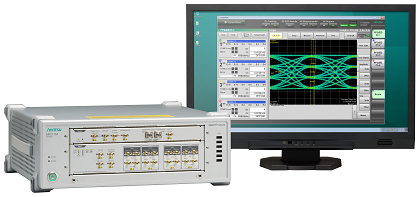Addition of Clock Recovery, PAM4 Analysis, and Jitter Analysis Functions
 January 17, 2018 – Anritsu Corporation (President Hirokazu Hashimoto) announces the release of three new Clock Recovery, PAM4 Analysis, and Jitter Analysis options to upgrade the functions of its BERTWave MP2110A Sampling Oscilloscope for manufacturing and inspecting optical modules and devices.
January 17, 2018 – Anritsu Corporation (President Hirokazu Hashimoto) announces the release of three new Clock Recovery, PAM4 Analysis, and Jitter Analysis options to upgrade the functions of its BERTWave MP2110A Sampling Oscilloscope for manufacturing and inspecting optical modules and devices.
[Development Background]
Data traffic volumes are growing exponentially as fast-growing providers offer new unique services to users. As a result, optical modules supporting these services are switching to faster speeds of 200 and 400 Gbit/s while the transmission format is evolving from the earlier NRZ technology to PAM4[*1]. On the other hand, the need to evaluate the performance of actual modules in use requires provision of trigger signals to evaluate transmission equipment optical interfaces, as well as separation of Jitter components, etc. Consequently, to meet these diversifying measurement needs and manufacturing of PAM4 optical modules, Anritsu has added these highly effective options to the MP2110A to help shorten inspection times, increase production-line yields, and cut measurement equipment costs.
[Product Outline and Features]
In addition to the existing BER Measurement and EYE Pattern Analysis [*2], adding these three new functions supports Clock Recovery, Jitter Analysis[*3], and PAM4 Analysis using the all-in-one MP2110A. Each of these new options can be retrofitted at any time to the MP2110A.
■ Option-095 PAM4 Analysis Software
This option supports measurements required for evaluating PAM4 optical signals, such as TDECQ [*4].
- No complex settings and easy capture of measurement results
- Low noise (3.4 µW typ.) and high-sensitivity oscilloscope supports high-reproducibility measurements even with small EYE margin PAM4 signals
- High-speed sampling shortens time for collecting data required for TDECQ analysis; cutting measurement time helps improve productivity at PAM4 signal evaluation
■ Option-054 Clock Recovery (Electrical/Optical)
This option recovers the trigger signal required by the sampling oscilloscope from the input data signal. It can be used for monitoring waveforms, such as for transmission equipment without a clock source.
- Built-in design supports easy and low cost measurement system configuration without complex cabling
- Supports recovery of both NRZ and PAM4 clocks to help cut equipment costs
- Reduces losses due to MP2110A internal dividers to minimize impact on sensitivity, which is especially useful for high-sensitivity monitoring of PAM signals
■ Option-096 Jitter Analysis Software
This option supports separate analysis of different Jitter components, such as TJ, DJ, RJ, etc.
- Supports fast and easy measurements required by J2, J9, etc., manufacturing inspection (EYE Mode)
- Supports detailed DJ analysis (Advanced Jitter Mode)
- Supports simultaneous Jitter analysis and EYE Mask tests to shorten measurement time[ Please visit below link for more product details] ⇒Link
https://www.anritsu.com/en-IN/test-measurement/products/mp2110a
[Target Markets and Applications]
■ Target Markets: PHY Layer Performance Evaluation for Optical Modules (CFP2/4/8, QSFP28, SFP28, OSFP, QSFP-DD, etc.), Active Optical Cables and Optical Device
■ Applications: Manufacturing and inspection of Optical Modules and Optical Devices
[Technical Terms]
[*1] PAM4
PAM is the abbreviation for Pulse Amplitude Modulation, which is a method for increasing transmission capacity using amplitude modulation; PAM4 is a fourth-order amplitude modulation method.
[*2] EYE Pattern Analysis
This method analyses the Eye Pattern waveform by summing the periodic signal waveforms. It is called an EYE pattern because the displayed signal waveform looks like an eye. The signal quality is evaluated as high when the waveform is drawn repeatedly over the same position but if the repeatedly drawn waveforms drifts, the signal is evaluated as being poorly transmitted.
[*3] Jitter Analysis
When transmitting electrical signals, the signal arrival time changes due to the impact of factors, such as the propagation path characteristics and external environment. This delay time variation is called Jitter. Jitter-separation analysis separates the components by generation source and properties for analysis.
[*4] TDECQ
TDECQ is the abbreviation for Transmitter and Dispersion eye Closure Quaternary. At IEEE-specified evaluation of PAM4 optical signal quality, the measurement items change to the NRZ EYE Mask test.






